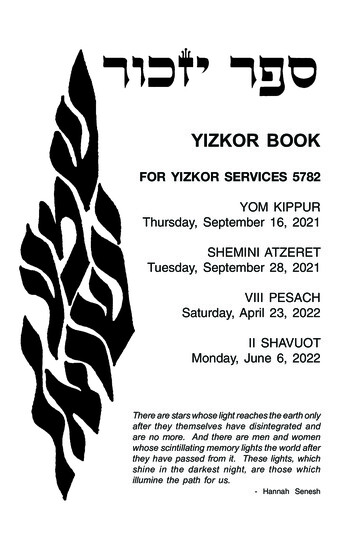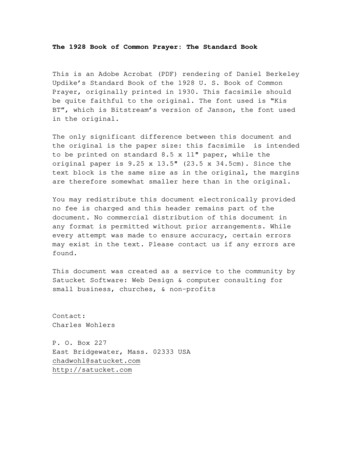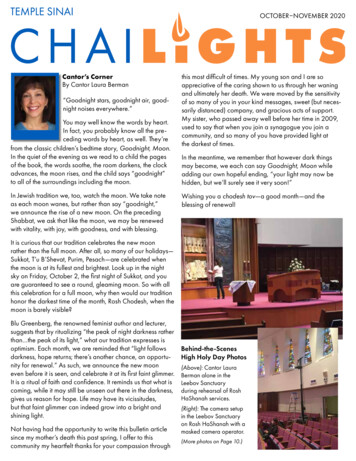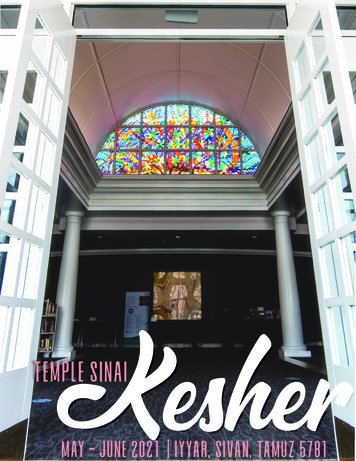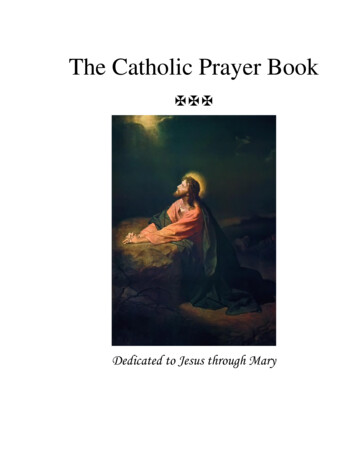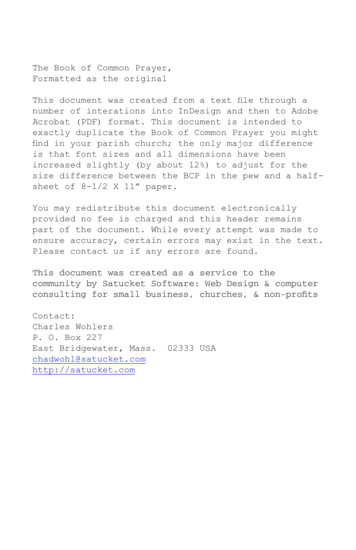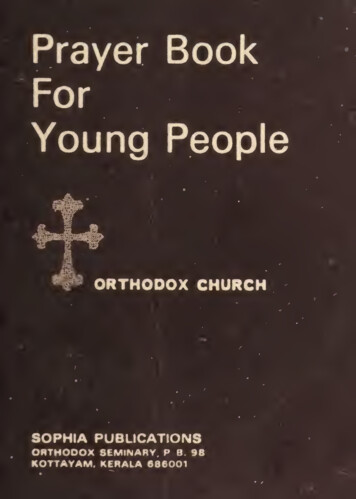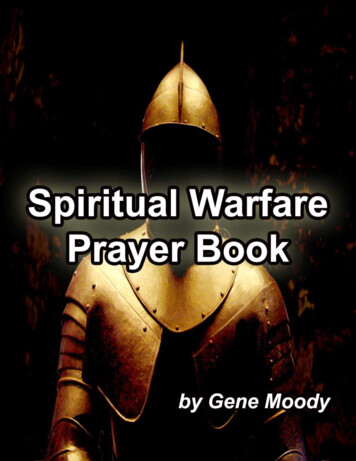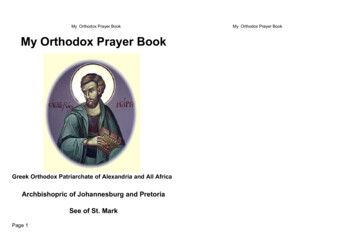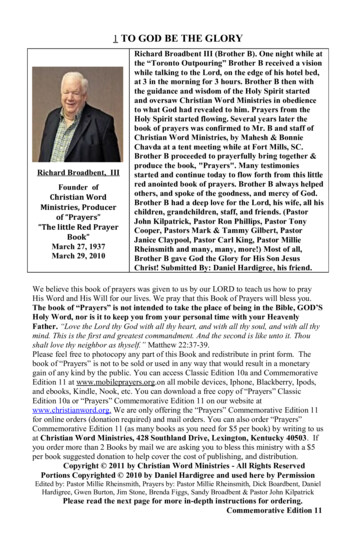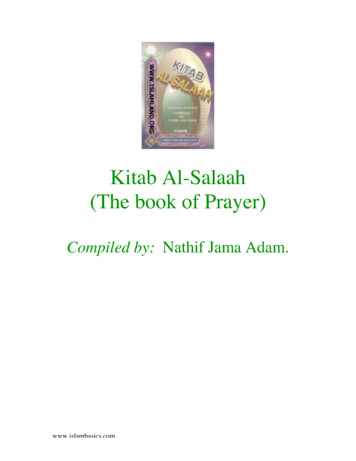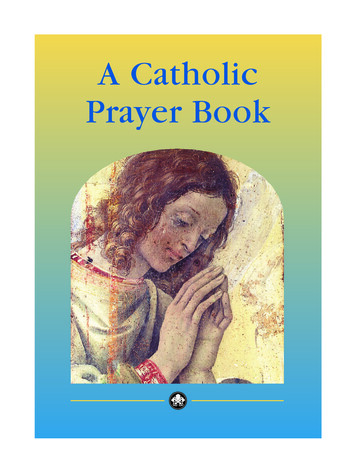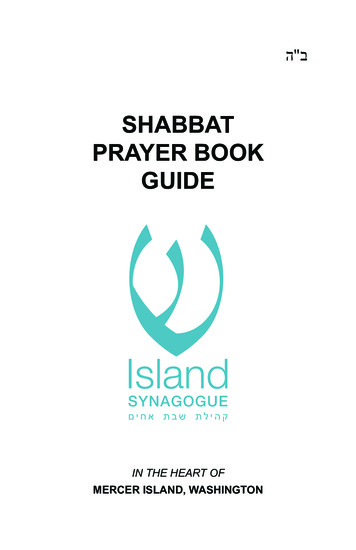
Transcription
ב"ה SHABBATPRAYER BOOKGUIDEIN THE HEART OFMERCER ISLAND, WASHINGTON
Copyright 2016 by Island SynagogueKehillat Shevet AchimISBN: 978-1-59849-214-9Printed in the United States of AmericaThe material in this booklet is considered holybecause of the Torah explanations it contains andcannot be thrown out or destroyed improperly.Island SynagogueKehillat Shevet Achim8685 SE 47th StreetMercer Island, Washington 98040206-275-1539www.islandsynagogue.orgAll rights reserved. No part of this book may be transmittedin any form or by any means, electronic or mechanical, includingphotocopying, recording, or by any information storage or retrievalsystem, in part, in any form, without the permission of the author.Requests for such permissions should be addressed to:Classic Day Publishing943 NE Boat StreetSeattle, Washington 98105206-860-4900www.classicdaypub.com
THIS PUBLICATIONHAS BEEN MADE POSSIBLEBY THE GENEROUS SUPPORTOFNATASHA & ELI SRULOWITZ
INSCRIPTION ON THE ARON KODESHV’ASUE LEE MIKDASH V’SHACHANTEE B’TOCHAM.THEY SHALL MAKE FOR ME A SANCTUARYAND I WILL DWELL IN THEIR MIDST.THE PAROCHETThe parochet (curtain) was designed byJeanette Kuvin Oren.The blue design in the lower half of the parochet represents theparting of the Sea of Reeds as the Israelites left Egypt. G-d ledthe Israelites through the wilderness with a column of smoke andfire, represented by the yellows and reds in the form of the Hebrew letter “shin” – a symbol for G-d’s name. The design is organized in a grid of five columns, representing the five books ofthe Torah, and ten rows for the Ten Commandments. Material forthe curtain is hand-dyed silk in a variety of textures and quiltedfor interest and durability, accented with gold cord and lined in alightweight satin.1
A personal messagefrom the RabbiWelcome to Island Synagogue: Kehillat Shevet Achim.We are honored that you have joined us on this HolyDay. We hope that this publication will enhance yourprayer experience, infusing it with meaning and joy.Our Hebrew name “Kehillat Shevet Achim” means the“Congregation where family dwells.” All who enter ourcampus are welcomed unconditionally as family. Weattempt to lead our services in a meaningful way, adhering to over three thousand years of tradition. TheTorah and Siddur are as inspiring today as they werethree millennia ago, when our ancestors engaged inthis spiritual experience in our Holy Land of Israel andthe Diaspora.Knowledge is the basis for understanding so you areencouraged you to ask the Rabbi and other congregants any questions or clarifications you seek.Wishing you a Shabbat Shalom.Rabbi Yechezkel Kornfeld2
INTRODUCTIONWELCOME TO ISLAND SYNAGOGUEKEHILLAT SHEVET ACHIMThe Jewish Shabbat (Sabbath) prayers begin at sunset on Friday with the Maariv service and concludes onSaturday, just before sunset with the Mincha service.This booklet will help you to follow and understand ourShabbat morning services.Shevet Achim is a Modern Orthodox synagogue. Theliturgy and the language of the Tanach (Holy Scriptures) and the Mishnah (Oral Law) is primarily Hebrew.Prayers may also be recited in English.We use two books during our prayer service on Shabbat – the Artscroll Siddur (prayer book) and the StoneChumash (Five Books of the Torah). The Chumashalso contains the weekly readings from the Prophetsas well as commentary and explanations of the texts.Hebrew is read from right to left. In our Siddur and Chumash, Hebrew text appears on the right-hand pageand is translated on the left-hand page. Pages will beannounced or indicated throughout the service. Thisbooklet also provides the page numbers for most ofthe important and noteworthy elements of the service.There is also a glossary at the end of this booklet thatwill help with unfamiliar words and terms.“If you are not a better person tomorrow than youare today, what need have you for a tomorrow?”Rabbi Nachman of Breslov3
DECORUMDress: We ask both men and women to dress modestly and appropriately for services and whenever entering the synagogue building. We dress up for services,especially on Shabbat to honor the day and show reverence for G-d’s house of prayer.Telephones: Telephones are not allowed to be usedon Shabbat or other holidays except for emergency situations or for professional situations (physicians, dentists, etc.), per a Halachic ruling from a Rabbi.Photography: Taking pictures of any kind is not allowed in any part of the synagogue or its grounds between Friday night before services until Saturday nightafter services or on Jewish Holy Days.Separation between men and women: During prayerservices, women and men are separated by a Mechitzah (partition), which enables all to concentrate on theirspiritual needs without overt interaction.Talking: The synagogue sanctuary is a wonderfulplace to interact socially with friends and relatives,some of whom we may not have seen recently. Pleaserespect those praying in the sanctuary by avoiding orminimizing conversation. It is permissible to conversesoftly in the foyer or other parts of the facility, or youmay want to wait to talk during the Kiddush (reception)after services.Children: We welcome children to our synagogue. Wehave a number of activities during services for yourchildren, according to their ages, and encourage parents to direct their children to these activities. We re4
quest that parents take responsibility for the actions oftheir children and guide them to places and activitieswhere they can behave well.“Who is wise?One who learns from all.”Ben Zoma – Pirkei AvosUNDERSTANDING PRAYER(TEFILLAH)Judaism has a unique outlook on prayer. In fact, theterm “prayer” has a deeper meaning. Prayer (Tefillah)means attachment, connection, or cleaving. The prayerexperience is not just a shopping list of personal needs;this is only one component. The essence of prayer isG-d. We invoke verses from scripture and quotationsfrom Rabbinic literature focusing on the greatness anduniqueness of G-d. In a sense, the prayer experienceenables and empowers us to stop being self-centeredand become G-d-centered.The Sages derived from the way Moses prayed to G-dthat prayer has three components: praise, request,and gratitude.Before we present our personal requests, we must become aware of the greatness of G-d, Whom we arepetitioning. That is why so much of the text of prayercontains Scriptural verses praising G-d. Then we proceed to pray and petition G-d for our personal, communal, and national needs. This teaches us that all5
our efforts in the natural world are granted and attainedonly because of G-d’s blessing. Finally, we thank G-dfor all He has provided us in the past.The prayer experience reinforces Judaism’s fundamental teachings that G-d is the only true reality onWhom we are totally dependent.There is a Biblical obligation to pray to G-d daily andrequest our needs. The Rabbis institutionalized thetext of prayer and its frequency. The Patriarchs introduced praying three times a day: at the start of a newday (Maariv Service), which occurs after sunset; in themorning (Shacharit Service); and before sunset (Mincha Service). The Rabbis obligated these prayers afterthe destruction of the Temple in Jerusalem to replacethe Temple service.The Mitzvah of prayer is fulfilled by reciting the Amidah, also called the Shemoneh Esrei or the Standing or Silent Prayer. The prayers recited before theAmidah prepare us for it, and the prayers recited afterthe Amidah enable us to bring the Amidah experiencedown to earth.The Amidah is recited when a Jew stands before G-d,like a subject before a king, praising, beseeching, andthanking Him. It is an intensely personal, spiritual experience and is the apex of the prayer service.Shabbat prayer prepares us for the coming week.Daily prayer prepares us for the coming day.Rabbi Jonathan Sacks6
THE STRUCTURE OF THE AMIDAHThe Amidah always has three (3) parts:1. The first three (3) blessings2. The middle blessing(s)3. The last three (3) blessingsOn weekdays there are 13 middle blessings. Theyare prayers/requests for our personal and communalneeds. On Shabbat and festivals these 13 blessingsare replaced by one longer blessing.The first three (3) blessings of every Amidah are:1. The merit of the Patriarchs2. G-d’s might and the resurrection of the dead3. The holiness of G-d’s nameThe middle blessing for Shabbat and Festivals is:4. The sanctity of the dayThe last three (3) blessings of every Amidah are:5. The restoration of the Temple Service6. The giving of thanks7. The request for peace7
THE SATURDAY MORNING SERVICEShabbat morning services are made up of threesections:A. ShacharitThe first part of the morning service, on bothShabbat and during regular weekday morningservices, includes:1. Birchot HaShachar (morning blessings)2. Pesukei D’zimrah (Verses of Praise)3. The Shema (a declaration of the principalof our faith) and its blessings4. The Amidah, reflecting the day’s themeof creation and rest, replacing the standard weekday format of the Amidah.B. Torah1. The Torah scroll is taken out of the AronHaKodesh (Holy Ark).2. It includes the reading of the weekly Parsha – the designated portion of the Torahfor that Shabbat.3. The Haftorah is read – the designatedreading of the Prophets for that Shabbatthat reflects the theme of the Parsha.8
4. The new month is blessed (whenapplicable).5. The Torah is returned to the Ark.C. Mussaf:1. An additional Amidah, which commemorates the added communal offerings forfestive days, like Shabbat, Yom Kippur,and Rosh Chodesh (New Month).2. Concluding prayernotes:*Tallit: Many Jewish men wear a prayershawl for all morning prayers.*Minyan: While many of our prayers canbe recited by individual Jews, some special prayers require a Minyan, a quorumof ten adult men. These are Kaddish,Borchu, Kedusha, and the Torah reading.*Chazan: For communal prayer, the service is led by a Chazan, also called theagent of the community or cantor.“Torah is not education, it is transformation.”Rebbitzen Dena Weinberg9
A. SHACHARIT1. BIRCHOT HASHACHAR Birchot HaShachar (Morning Blessings) page19: These blessings help us recognize our circumstances in life and thank G-d for clothingus, sustaining us, guiding us, and recognizingour actions to improve the world and do ourduty as Jews. Kaddish d’Rabbanan (Rabbi’s Kaddish) page53: At this point, people who are in mourning fora loved one who has passed away within thelast year, or those who have a loved one whodied on this date in the Hebrew calendar, recitea prayer called Kaddish.NOTES:*Kaddish is not a prayer of remembrance,but instead praises and magnifies G-d’sname and expresses our hope for eventualredemption. If one cannot read the prayer inHebrew, he/she may use the English transliteration of the prayer on page 1042.*In our services we say three types ofKaddish. The Rabbi’s Kaddish is recited afterwe say a portion of the Talmud or Midrash.The Mourner’s Kaddish is recited by mourners to elevate the soul of their loved one.The Chatzi Kaddish is recited by the Chazanat the end of a defined group of prayers.After Kaddish, we turn to page 369.10
2. PEsukei D’zimraH (Verses of Praise)Taken primarily from the Psalms of King David,these verses prepare us for the Amidah, as theyexpress our appreciation and understanding ofG-d’s greatness. Mizmor Shir (A Song for the Inauguration of theTemple by David) on page 369 refers to the inauguration of the Temple service in ancient times.Notes on page 55 provide further explanation. Baruch Sheamar (“Blessed is He who spoke ”)on page 371. This blessing introduces thePesukei D’Zimrah. We stand, and men gatherthe front two strands of their Tallit together andat the end of that paragraph, kiss them, releasethem, and we may sit. The reader and congregation continue with the recitation of Psalms. Hodu (“Give thanks.”) on page 385 is a recitation of Psalm 136, during which we stand in tribute. It is also called the Great Psalm of Praise,since its verses celebrate G-d’s kindness fromthe immensity of creation to the universality ofgiving each creature its sustenance. At its conclusion we may be seated. Ashrei (“Praiseworthy are those.”) on page391 is repeated three times a day, this being thefirst time. A commentary on page 66 explains theimportance of this prayer. We continue, seated,until page 397.11
Va’Yivarech David (“And David blessed.”) onpage 397 begins a section of the service wherewe stand in respect for the many miracles detailed in Va’yoshah. Va’yoshah (“God saved ”) on page 399 is thefamous “Song at the Sea,” a celebration of ourleaving Egypt and the miracle of the splitting ofthe sea. This detailed narration emphasizes thepower of G-d and His promise to free us fromour enslavement.At this point, we begin the more melodic and centralsection of the service. In many congregations a different Chazan may take over, or the individual leadingPesukei D’Zimrah continues. Shochain Od (“He who abides ”) on page 405is the final series of prayers in this section. Yishtabach (“May Your Name be praised.”)mid-page 405 is said standing without pause. Itis the concluding blessing of Pesukei D’Zimrah. Half-Kaddish (Chatzi Kaddish) on page 407 isrecited by the Chazan, denoting completion ofthis section of the prayer service.3. BLESSINGS OF THE SHEMA and shema Borchu (“Bless G-d.”) mid-page 407, the Chazan bows while saying the Borchu, loudly, andwhen he completes this phrase, we all bow andrecite the sentence below it – “Blessed is G-d,the Blessed one, for all eternity.”12
Kel Adon (“G-d, the Master ”) on page 411 isa liturgical poem sung by the congregation. Thispoem’s Shabbat recitation is a reflection of ourgreater ability to see just a little more of G-d’sgreatness on that day. The Shema (“Hear, O Israel ”) on page 415.The paragraphs associated with the Shema are takendirectly from the Torah. The third paragraph instructsmen to wear “tsitsit” fringes for all time.NOTES:*The men have gathered the four fringes,one from each corner of their prayer shawls,and are holding them in their left hands. Inunison we declare the principal of our faith– Hear, O Israel: The Lord is our G-d, TheLord is One.*While reciting The Shema, the eyes arecovered with the right hand, symbolicallyblocking all outside distractions while concentrating on this tenet of faith, immediatelyfollowed, in an undertone, by “Blessed is thename of His glorious kingdom for all eternity.”*At V’yomer (“And G-d said ”), in the thirdparagraph of The Shema, men transfer thefringes to their right hand, and every timethey encounter the word tsitsit, they kissthe fringes.13
The Shema ends at the bottom of page 419, and thecongregation stands in preparation for the most reveredpersonal prayer in the Shacharit service, the Amidah.4. AMIDAHOn a regular Shabbat, the Amidah starts on page 421.(See notes on the Amidah structure on page 7.)NOTES:*Many communities outside Europe retaintheir own customs regarding standing or sitting, adding prayers, etc., but the Amidah isuniversally recited standing.*During this prayer, congregants stand withfeet together in silence and do not movethem until completion of the Amidah. To foster immersion in the prayer, it is forbidden topray out loud or recite prayers loud enoughfor close neighbors to hear.At the end of the Amidah, on page 431, we take threesteps backward, bowing left, right, and forward, symbolically leaving the presence of the King.Once the general congregation has finished the prayer,the Chazan repeats the entire Amidah.NOTES:*For most of Jewish history, few could afford prayer books. Those who had them orknew it by heart recited the Amidah them14
selves. Those who did not would listen tothe Chazan’s repetition intently and answer“Amen” to all the blessings and thereby fulfill their obligations to recite the Amidah. Inmodern times, when everyone has accessto a Siddur, the repetition enables congregants to respond to Kedusha, Modim, andthe blessings with “Amen.”*There is a Rabbinic obligation to respond“Amen” when a Bracha is heard. “Amen”means we believe that the Bracha isabsolutely true and we await its fulfillment.There is a custom to respond “BaruchHu Uvaruch Shmo” – “Blessed is He andBlessed is His Name” – when G-d’s name isheard in a Bracha.We return to page 421 for the Chazan’s repetition ofthe Amidah. After a few paragraphs, everyone stands. Kedusha is on page 423, with a commentaryon page 100. This insertion is yet another sanctification of G-d’s glory. Everyone stands andresponds to the Chazan in unison. When theKedusha is finished, we may be seated. Modim (“We gratefully thank You ”) on page427 is another individual prayer within the Amidah thanking G-d for shielding and saving us.We rise and bow at the start of this prayer andread the words in the gray box.After we end the Shemoneh Esrei on page 431, theChazan recites Kaddish.15
B. TORAH READINGThe Torah is the central core of Judaism. It is readtwice every Shabbat, in the morning and in the afternoon service with the start of next week’s reading. It isalso read every Monday and Thursday morning andfor the new month and festivals. Many people spendtheir entire lives studying Torah and its commentaries.A great many Jewish people attend classes on a regular basis here at Island Synagogue and elsewhere tofurther increase their understanding of the Torah.NOTES:*While our printed books have dots and marksunder the letters (the markings are vowels),the Torah scroll does NOT have them. TheTorah reader will have studied or memorizedthe portion over a period of time, reviewing hispronunciation to make sure he is letter-perfect.*The Torah scroll is hand-printed, using selected parchment and an ink recipe thousands ofyears old. The scribe who writes it must ensurethe highest level of spiritual purity before beginning his work each day.1. Removal of the Torah from the Ark Ain Kamocha (“There is none like You ”) onpage 433 emphasizes G-d’s greatness and aplea to rebuild Zion.16
At the appropriate signal, the Torah or Torahs neededfor the service can be removed. Depending on the timeof year, there may be up to three scrolls removed fromthe Ark.When the Ark is opened, everyone stands in respectfor the Torah’s Holiness. Once the appropriate initialprayers are said, the Chazan will carry the Torah(s)around the sanctuary, bringing the Torah(s) close to thecongregants, many of whom will kiss it (directly, or withtheir prayer shawls). The Chazan places the Torah onthe Bimah (reading table).2. READING THE TORAHWhen the Torah is placed on the table and the scrollopened for reading, the congregation temporarily retires the prayer book (Siddur) and follows the Torahreading in the blue Stone Chumash on the page corresponding to the Parsha (chapter) that will be read fromthe Torah. The initial page number will be announced,along with the name of the Parsha.Aliyah (Going up). Usually seven men are honored onShabbat by being called up to the Torah. The blessingrecited by the person receiving the Aliyah is found onpage 440. A copy is also on the Bimah.The first Aliyah, invariably, will be a Cohen, a memberof the Priestly class – direct patrilineal descendent ofAaron, the High Priest.The second to be called up is a Levi, the tribe honored tolook after the Ark and its religious articles during its travels in the desert. Tribal members were also teachers.17
After the first two Aliyot, the remaining honors are given to family members celebrating occasions such asBar/Bat Mitzvah, Brit Milah (circumcision), baby naming, Yahrzeit (anniversary of the death of a loved one),Ufruff (honoring a bridegroom on his upcoming marriage), or others selected by the Rabbi.NOTE:*The order of Aliyot:1st: Cohane or Rishon 5th: Chamishee2nd: Levi or Shani6th: Sheeshee3rd: Shlishi7th: Sh’vee’ee4th: R’vee’ee8th: Maftir** Given to person who will chant the Haftorah.After the Parsha is completed, Chatzi Kaddish isrecited.At this point, prayers for health are offered, as wellas special prayers for the land of Israel and the IsraelDefense Forces.The individual who will chant the Haftorah is given theMaftir Aliyah.Two individuals receive the honor of lifting up the Torah, re-furling it, and dressing it for its return to the Ark.As the Torah(s) are lifted, the congregation stands inrespect, designating the scrolls while saying V’zohsHaTorah (“This is the Torah .”) on page 445.18
3. HAFTORAHHaftorah is really an echo. A solo act, it reflects theTorah portion we just read, but its origin is from theBooks of Prophets. Reading the Haftorah originatedwhen Jews reading the Torah was considered heresy by authorities of the non-Jewish community. Jewssubstituted a reflective thematic reading from theProphets, but once the right to read the Torah was regained, the tradition continued.4. BLESSING THE NEW MONTHBlessing the new Jewish month (Rosh Chodesh) appears on page 452.The Shabbat before Rosh Chodesh is called ShabbatMevarchim – the Shabbat of blessing. A petition to G-dfor a blessed new month is followed by announcing theexact time of the appearance of the new moon, whichdetermines the beginning of the new month.The Chazan announces when Rosh Chodesh will beobserved and concludes with a prayer for life, peace,joy, salvation, and consolation.This reminds us that in Temple times the Sanhedrin, the Jewish Supreme Court, would declare RoshChodesh based on witnesses testifying to the appearance of the new moon. When Moshiach (Messiah)comes, this method will be reinstituted, ending our reliance on calendars.19
5. RETURNING THE TORAH TO THE ARK Yekum Purkan (“May Salvation Arise.”) onpage 449 is a prayer praising and asking forDivine protection on behalf of our Rabbis andreligious officials, as well as leaders; next, formembers of the Community; followed by a thirdparagraph for givers of charity and those wholook after the needs of the entire community. Ashrei (“Praiseworthy are those ”) page 457is repeated for the second time. Yehalelu (“Let them praise.”) on page 459.The Torah(s) are returned to the Ark, carried by theChazan and others, who reverse the original paththrough the congregation. The Ark is closed, participants return to their seats, and all may be seated.ANNOUNCEMENTSBefore proceeding to the final service (Mussaf), announcements are made either by the synagogue president or the Rabbi. The Rabbi may also elect to give asermon at this point in the service.“It is a tree of life for those who support it, and itssupporters are praiseworthy. Its ways are ways ofpleasantness, and all its paths are peace.”Proverbs 3:18 & 3.1720
C. MUSSAF (Additional Service) Mussaf Amidah on page 463 is preceded byKaddish on the bottom of page 461 for a regularShabbat service. For a Shabbat that involves afestival or holy day, a special Mussaf is recitedexpressing extra joy over the holiday or recounting the special sacrifices at the Temple.The Amidah is recited silently while standing, as described previously.There are many reasons for Mussaf. The additionalservice speaks to the ability of the congregation todevote more time to the prayers, since there is nowork done on the Sabbath. This also reflects the timeduring the Temple service when additional sacrificeswere made.Once again, the Chazan repeats the Amidah aloud inits entirety when the congregation has finished their individual prayers. Kedusha on page 465 is slightly different fromKedusha in Shacharit, reflecting a higher spirituality in this service (see commentary on page464). Again, the Kedusha is offered standing.The repetition continues. The congregation rises, bows, and straightensup for the Modim (thanksgiving) prayer, readingthe words in the gray box on page 471.Kaddish on page 475 indicates we have finished thismajor section of the service.21
Concluding Prayers. At this point, theChazan or prayer leader leaves the Bimah,and his place is normally taken by boys underthe age of 13 (pre-Bar Mitzvah), although anyyoung man who is competent to lead the services, tested in advance for speed and accuracy,may lead congregation.NOTE:* The boys are each wrapped in a Tallit (prayershawl), as all men leading the congregationin prayer must wear a Tallit.Ein Kelokainu (There is none like our G-d )on page 477 is sung together. It is a short paragraph praising G-d, our Master and Savior.Praying individually, we learn a series of Talmud portions on everything from the correct compoundingof the spices for the incense to increasing peace inthis world. Adding Talmud to prayer leads those whoare mourning or observing a Yahrzeit into saying theRabbi’s Kaddish at the top of page 481. Aleinu (“It is our duty.”) on page 481 is recitedstanding. At the point where we read “we bendour knees, bow.,” we only bow. At the end ofAleinu, the mourners recite Kaddish again. Anim Zmirot (“Song of Glory”) is on page 485(“I shall compose pleasant Psalms.”). Thedoors to the Ark are opened, and only then dowe begin this poem, standing. It is sung responsively, with the prayer leader or children recitingone line, and the congregation replying with the22
next line. Once finished, the Ark is closed andthe mourners again say Kaddish.The last section of prayer is the Psalm of the day(today Shabbat) on page 489, followed by mourners’Kaddish, which may be delayed if the Congregationreads Lamnatzeah. Lamnatzeah (“For the Conductor ”) on page153 is a Psalm beseeching G-d to help us in ourtime of distress, followed by Kaddish on page 157. Adon Olam (“Master of the Universe ”) onpage 12 is a short liturgical poem, traditionallysung at the end of Shabbat services. SHABBAT SHALOMWe hope you have enjoyed the serviceand have been inspired to join us again.Please join us after servicesfor a Kiddush luncheon in our social hall.23
GLOSSARYALIYAH: Literally “going up”; the honor one isaccorded for the reading of a portion of the Torah.AMIDAH: Also known as the Shemoneh Esrei; thesilent standing prayer central to every service.ARON HAKODESH: Holy Ark that houses the Torahs.BAR MITZVAH: Son of the commandment; a Jewishboy of 13 years old.BAT MITZVAH: Daughter of the commandment; aJewish girl at 12 years old.BIMAH: Most commonly referring to the raised areawhere the Torah is read and the table on which it isplaced.BRACHA: Blessing. A benediction recited beforeeating, drinking, or doing a Mitzvah.BORCHU: Is recited by the prayer leader whenpraying with a minyan in the middle of the morningservice and the beginning of the evening service.He tells the congregation to “Bless Hashem Who isblessed,” and they respond “Blessed is Hashem Whois blessed forever.”BRIT MILAH: Ritual circumcision performed on the 8thday after birth to every healthy Jewish male.CHATZI KADDISH: Half Kaddish, recited at theconclusion of parts of the prayer service.CHAZAN: Cantor, one who leads the prayers in frontof the congregation.CHUMASH: Contains the Five Books of Moses(also called the Pentateuch) and readings from theprophets.24
COHEN (COHANE): A male who is a patrilinealdescendant of Aaron the high priest, usually honoredwith the first Aliyah.GLILLA: One who dresses the Torah after its reading.HAFTORAH: Readings from the prophets (Nevi’im)chanted on Shabbat and festivals after the Torahreading.HAGBA: One who lifts and holds the Torah while it isbeing dressed.HASHEM: Literally “The Name” referring to G-d.KADDISH: Prayer written in Aramaic extolling the virtuesof G-d, said by mourners or individuals rememberingthe anniversary of one who has passed on.KEDUSHA: Is recited during the repetition of theAmidah when the congregation declares Hashem’ssanctity by reciting the verses in Scripture said to bethe words of the angels.KEHILLAH: CommunityKEHILLAT: Community ofKIDDUSH: The Friday night blessing that acknowledgesthe sanctity of the Shabbat. Tangentially it also refersto the food served after the Shabbat morning service.LEVI: From the tribe of Levi; usually the second Torahreading honor.MAARIV: The first service of the day, occurring after dark.MIDRASH: Rabbinic literature consisting ofanthologies and homilies.MINCHA: The third service of the day, occurringbefore dark.25
MINYAN: A gathering of at least ten Jewish post-BarMitzvah males at a service, which allows the readingof the Torah and the saying of Kaddish, Kedusha,and Borchu.MISHNAH: Record of the Oral Law expoundingthe Torah.MITZVAH: A commandment, either Biblical orRabbinic.MOSHIACH: Messiah.MOURNER’S KADDISH: Recited by those inmourning or those observing an anniversary of thedeparture of someone.MUSSAF: Third service of Shabbat.PARSHA: That portion of the Torah readingdesignated for that week.PATRIARCHS: Refers to the fathers of monotheismand Judaism: Abraham, Isaac, and Jacob.ROSH CHODESH: New month.SHABBAT: Jewish Sabbath.SHACHARIT: Morning service.SHEMAH: Is the first word of the three-paragraphrecitation said daily during the morning and eveningservices.SHEMONEH ESREI: Also referred to as Amidah.SHEVET ACHIM: Brothers dwelling/sitting together.SIDDUR: Daily prayer book.TALLIT (Tallis): Prayer shawl worn by post-BarMitzvah men; some unmarried men do not wear a tallit.26
TALMUD: Consists of the Mishnah and the Gemara,the primary record of the Oral Torah.TANACH: Hebrew Bible containing the Five Books ofMoses, the Prophets, and the Writings.TORAH: Sacred scroll containing the Five Booksof Moses.TSITSIT (Tzitzis): Four fringes on each of the Tallit’sfour corners.UFRUFF: The honor a male is accorded for a readingof the Torah before his wedding.YAHRZEIT: The anniversary of the deceased,according to the Hebrew calendar.27
Original Composition byAaron H. RosenthalFor Schara Tzedeck Synagogue, Vancouver, B.C.Editorial Assistants:Rabbi Stephen Berger, M.Ed.Alexander Hart, Ph.D.Alan Moranis, Ph.D.Island SynagogueKehillat Shevet AchimMercer Island, WashingtonContributors and Editors:Rabbi Yechezkel KornfeldEdward Epstein, D.D.S.Joel BaskinJo KershawRobert Kahn, Ph.D.Carol Teitz, M.D.Diane Medved, Ph.D.201628
We use two books during our prayer service on Shab-bat – the Artscroll Siddur (prayer book) and the Stone Chumash (Five Books of the Torah). The Chumash also contains the weekly readings from the Prophets as well as commentary and expl
